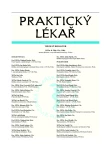Food craving: Food-Craving Questionnaire – Trait
Authors:
M. Světlák 1,2; M. Černík 1
Authors‘ workplace:
Masarykova univerzita, Brno
Lékařská fakulta
Fyziologický ústav
Přednostka: prof. MUDr. Nataša Honzíková, CSc.
1; Přednosta: prof. MUDr. Jiří Raboch, DrSc.
2; Univerzita Karlova, Praha
1. lékařská fakulta
Psychiatrická klinika
2
Published in:
Prakt. Lék. 2010; 90(1): 44-47
Category:
Of different specialties
Overview
Recent findings show that food craving is strongly related to body weight and causes excessive eating patterns observed in obesity, binge eating and bulimia nervosa and its severity represents a good predictor of relapse. Our study aimed to validate the Czech translation of the General Food-Craving Questionnaire - Trait (G-FCQ-T) that currently represents one of the most reliable tools for food craving measurement. In order to achieve this goal we measured indices of food craving in 257 university students. The statistical analysis of the acquired data revealed that the Czech version of the G-FCQ-T has satisfactory psychometric properties and it is ready to be used in common clinical practice.
Key words:
General Food-Craving Questionnaire – Trait, food craving, obesity therapy, weight control.
Sources
1. Pelchat, M.L. Of human bondage: food craving, obsession, compulsion, and addiction. Physiol. Behav. 2002, 76, p. 347-352.
2. Mercer, M.E., Holder, M.D. Food cravings, endogenous opioid peptides, and food intake: a review. Appetite 1997, 29, p. 325-352.
3. Weingarten, H.P., Elston, D. Food cravings in a college population. Appetite 1991, 17, p 167–175.
4. Cepeda-Benito, A., Fernandez, M.C., Moreno, S. Relationship of gender and eating disorder symptoms to reported cravings for food: Construct validation of state and trait craving questionnaires in Spanish. Appetite 2003, 40, p. 47–54.
5. Sobik, L., Hutchison, K., Craighead, L. Cue-elicited craving for food: a fresh approach to the study of binge eating. Appetite 2005, 44, p. 253-261.
6. Franken, I.H., Muris P. Individual differences in reward sensitivity are related to food craving and relative body weight in healthy women. Appetite 2005, 45, p. 198-201.
7. Hill, A.J., Weaver, C.F.L., Blundell, J.E. Food craving, dietary restraint and mood. Appetite 1991, 17, p. 187–197.
8. Nijs, I.M., Franken, I.H., Muris, P. The modified Trait and State Food-Cravings Questionnaires: development and validation of a general index of food craving. Appetite, 2007, 49, p. 38-46.
9. Berridge, K.C. Motivation concepts in behavioral neuroscience. Physiol. Behav. 2004, 81, p. 179-209.
10. Finlayson, G., King, N., Blundell, J.E. Is it possible to dissociate ‘liking’ and ‘wanting’ for foods in humans? A novel experimental procedure. Physiol. Behav. 2007, 30: p. 36-42.
11. Robinson, T.E., Berridge, K.C. The neural basis of drug craving: An incentive-sensitization theory of addiction. Brain. Res. Rev. 1993, 18, p. 247-291.
12. Buffenstein, R., Poppitt, S.D., McDevitt, R.M., Prentice, A.M. Food intake and the menstrual cycle: A retrospective analysis, with implications for appetite research. Physiol. Behav. 1995, 58, p. 1067-1077.
13. Jas, P.E. Changes in food intake and mood across the menstrual cycle. PhD Thesis: University of Reading, UK; 1996.
14. Covey, S.R. 7 Návyků opravdu efektivních lidí. Praha: Management Press, 2007.
15. Khantzian, E.J. The self-medication hypothesis of addictive disorders: focus on heroin and cocaine dependence. Am. J. Psychiatry 1985, 142, p. 1259-1264.
16. Christensen, L. The effect of food intake on mood. Clin. Nutrition. 2001, 20, p. 161-166.
17. Nieuwenhuizen, A.G., Rutters, F. The hypothalamic-pituitary-adrenal-axis in the regulation of energy balance. Physiol. Behav. 2008, 94, p. 169-177.
18. Di Chiara, G., Bassareo, V., Fenu, S. et al. Dopamine and drug addiction: the nucleus accumbens shell connection. Neuropharmacology, 2004, 47, p. 227-241.
19. Volkow, N.D., Wise, R.A. How can drug addiction help us understand obesity? Nat. Neurosci. 2005, 8, p. 555–560.
Labels
General practitioner for children and adolescents General practitioner for adultsArticle was published in
General Practitioner

2010 Issue 1
- What Effect Can Be Expected from Limosilactobacillus reuteri in Mucositis and Peri-Implantitis?
- Memantine Eases Daily Life for Patients and Caregivers
- Metamizole vs. Tramadol in Postoperative Analgesia
- Advances in the Treatment of Myasthenia Gravis on the Horizon
Most read in this issue
- Mallet finger
- Food craving: Food-Craving Questionnaire – Trait
- Practical application of bright light therapy
- Breast cancer in older women
